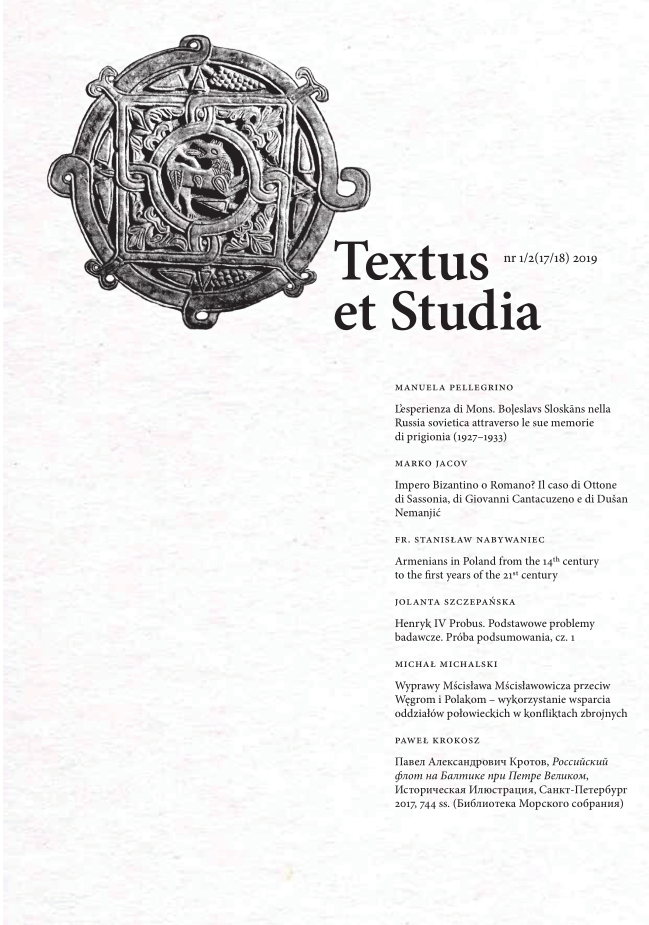The experiences of bishop Bolesław Sloskans in Soviet Russia based on his memoirsfrom prison (1927–1933)
DOI:
https://doi.org/10.15633/tes.05101Keywords:
Bolesław Sloskans, Soviet Russia, labor camps, Solovetsky IslandsAbstract
This article presents the memories of bishop Bolesław Sloskans from the Soviet labor camps (1927–1933). Marxist ideology regarded religion as the enemy of progress. Therefore, after the Bolsheviks took power, a period of systemic struggle with all its manifestations began. A huge sacrifice, apart from the Orthodox Church, was made by the Roman Catholic Church. Almost all Catholic clergy working in the USSR faced persecution at that time. Among them was also Bishop Bolesław Sloskans, from 1926 apostolic administrator in Belarus with the title of apostolic inspector of the Mogilev and Minsk dioceses. He was arrested for the first time in 1927. He was imprisoned for the second time in 1930. He spent six years in exile. He was released in 1933 through an exchange of prisoners from Latvia.References
Applembaum A., Gulag, Milano 2004.
Bardach J., Gleeson K., L’uomo del Gulag. Kolyma: i ricordi di un sopravvissuto, Milano 2006.
Boeckh K., I cattolici tedesco-russi negli anni 1917–1939 [in:] La Chiesa cattolica in Unione Sovietica. Dalla rivoluzione del 1917 alla Perestrojka, J. Mikrut (a cura di), San Pietro in Cariano 2017, pp. 213–215.
Brodskij J., Solovki. Le isole del martirio. Da monastero a primo lager sovietico, La casa di Matriona 1998.
Chenaux P., L’ultima eresia. La Chiesa cattolica e il comunismo in Europa da Lenin a Giovanni Paolo II, Roma 2011.
Codevilla G., L’impero sovietico 1917–1990 [in:] Storia della Russia e dei Paesi limitrofi. Chiesa e Impero, Milano 2018, pp. 81–89.
Judin A., Pie-Eugène Neveu, Milano 2002.
Kaplan H., Aspetti e problemi della bibliografia del Gulag [in:] Gulag. Storia e memoria, E. Dundovich, F. Gori, E. Guercetti (a cura di), Milano 2004, pp. 279–305.
La Chiesa cattolica in Unione Sovietica. Dalla rivoluzione del 1917 alla Perestrojka, J. Mikrut (a cura di), San Pietro in Cariano 2017.
Pellegrino M., Modernizzazione, totalitarismo e politica antireligiosa nella Russia staliniana, «Itinerari di ricerca storica» 2014, vol. XXVIII, no. 1 (nuova serie), pp. 163–182.
Pomerantsev P., Niente è vero, tutto è possibile. Avventure nella Russia moderna, Roma 2018.
Problemi dello status della gerarchia cattolica nelle trattative tra l’URSS e la Santa Sede negli anni Venti [in:] Santa Sede e Russia da Leone XIII a Pio XI, vol. II, Citta del Vaticano 2002, pp. 150–183.
Reati F.R., Dio dira l’ultima parola. La persecuzione della Chiesa cattolica in Russia in epoca sovietica, Gardolo 2003.
Roccucci A., Stalin e il patriarca. Chiesa ortodossa e potere sovietico 1917–1958, Torino 2011.
Rossi J., Manuale del Gulag. Dizionario storico, Napoli 2006.
Santa Sede e Russia da Leone XIII a Pio XI, vol. II, M. Valente (a cura di), Citta del Vaticano 2006.
Senko E., Storia della Chiesa nell’Unione Sovietica, Nowy Sącz 2008.
Tokareva E.S., La distruzione dell’organizzazione ecclesiastica in Unione Sovietica [in:] La Chiesa cattolica in Unione Sovietica. Dalla rivoluzione del 1917 alla Perestrojka, J. Mikrut (a cura di), San Pietro in Cariano 2017, pp. 79–89.
Tokareva E.S., Le relazioni tra l’URSS e il Vaticano: dalle trattative alla rottura (1922–1929) [in:] Santa Sede e Russia da Leone XIII a Pio XI, Citta del Vaticano 2002, pp. 199–261.
Vasil’eva O., Se il mondo vi odia… Martiri per la fede nel regime sovietico, La Casa di Matriona 1997.
Wenger A., La persecuzione dei cattolici in Russia. Gli uomini, i processi, lo sterminio. Dagli archivi del KGB, Cinisello Balsamo–San Paolo 1999.
Wegner A., Rome et Moscou, 1900–1950, Paris 1987.
Downloads
Published
Issue
Section
License
Copyright (c) 2021 Manuela Pellegrino

This work is licensed under a Creative Commons Attribution-NonCommercial-NoDerivatives 3.0 Unported License.
Authors publish under the Attribution-NonCommercial-NoDerivs 2.0 Generic (CC BY-NC-ND 2.0) license. In this case, authors have a range of rights, including:• The right to share or reuse their article in the same ways permitted to third parties under
• They can "copy and redistribute the material in any medium or format for any purpose, but not commercially. The licensor cannot revoke these freedoms as long as you follow the license terms."
• Authors retain patent, trademark, and other intellectual property rights (including research data).
• Authors receive proper attribution and credit for the published work.

